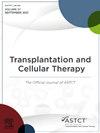同种异体造血干细胞移植后功能性免疫重建的时间演变。
IF 3.6
3区 医学
Q2 HEMATOLOGY
引用次数: 0
摘要
背景:同种异体造血干细胞移植(alloo - hsct)后的免疫重建(IR)目前是通过测量免疫效应器的绝对数量来监测的。然而,这种方法不能捕获功能性免疫能力。在这项研究中,我们旨在评估功能性IR与传统免疫细胞计数测量的时间演变。方法:在移植后6个月和12个月,对55名同种异体造血干细胞移植受者和10名健康志愿者进行了含有脂多糖或葡萄球菌肠毒素B的struculture®管全血刺激。采用NanoString®技术定量检测144个免疫相关基因的表达。根据人口统计学、临床特征和免疫细胞计数分析功能性免疫概况的时间随访。结果:同种异体造血干细胞移植后12个月的IR评估显示定量和定性评估之间存在显著差异。虽然免疫细胞计数有所改善,例如,受体达到正常CD4+ t细胞值的比例从25%增加到46%,但转录组谱显示出持续的功能改变。在移植后6个月观察到的较少诱导基因中,超过78%的基因在移植后12个月仍表现出表达减少。转录组免疫分析揭示了与临床特征相关的多种功能结果,这些结果不能单独通过细胞计数评估反映出来。结论:在此,我们强调仅对免疫效应物进行定量评估并不能提供足够的信息来对同种异体造血干细胞受体的功能性免疫能力进行分类。我们的研究结果强调了IFA作为全面了解同种异体造血干细胞移植后功能性IR的附加工具的价值,它可以作为一种简单有效的方法来实现个性化的移植后管理。本文章由计算机程序翻译,如有差异,请以英文原文为准。
Temporal Evolution of Functional Immune Reconstitution after Allogeneic HSCT
Immune reconstitution (IR) following allogeneic hematopoietic stem cell transplantation (allo-HSCT) is currently monitored by measuring the absolute number of immune effectors. However, this approach does not capture functional immune capacities. In this study, we aimed to evaluate the temporal evolution of functional IR alongside traditional immune cell count measurements. Whole-blood stimulation with TruCulture tubes (Myriad Rbm, Austin, TX, USA) containing lipopolysaccharides or staphylococcal enterotoxin B was performed on 55 allo-HSCT recipients at 6 and 12 months post-transplant, and on 10 healthy volunteers. The expression of 144 immune-related genes was quantified using NanoString technology (NanoString Technologies, Seattle, WA, USA) . The temporal follow-up of functional immune profiles was analyzed over time according to demographics, clinical characteristics, and immune cell counts. The evaluation of IR in allo-HSCT recipients up to 12 months post-transplant showed a significant discrepancy between quantitative and qualitative assessments. While immune cell counts improved, eg. the proportion of recipients reaching normal CD4+ T cell values, increasing from 25% to 46%, transcriptomic profiles showed persistent functional alterations. More than 78% of less-induced genes observed at 6 months still exhibited a reduced expression at 12 months post-transplant. Transcriptomic immune profiling divulged diverse functional outcomes linked to clinical characteristics, which were not reflected by cell count assessments alone. Herein, we emphasize that quantitative assessment of immune effectors alone is not informative enough to classify allo-HSCT recipients regarding functional immune capacity. Our findings highlight the value of implementing immune functional assay (IFA) as an additional tool for a comprehensive understanding of functional IR post-allo-HSCT, which could serve as a straightforward and efficient method for enabling personalized post-transplant management.
求助全文
通过发布文献求助,成功后即可免费获取论文全文。
去求助
来源期刊

Transplantation and Cellular Therapy
Medicine-Hematology
CiteScore
7.00
自引率
15.60%
发文量
1061
审稿时长
51 days
 求助内容:
求助内容: 应助结果提醒方式:
应助结果提醒方式:


